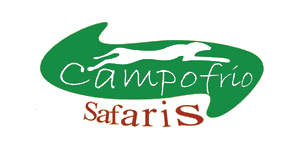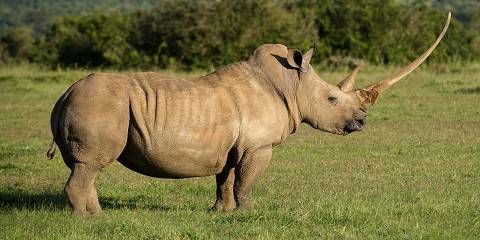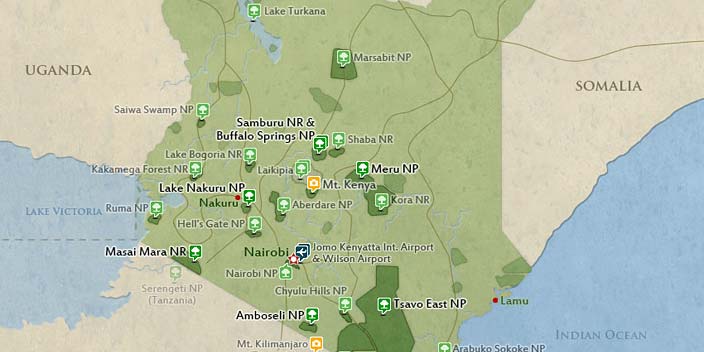
Arrival
Arrival
Day 1
Nairobi - Archers Post
Nairobi - Archers Post
You'll have an early morning departure from Nairobi and drive north towards Nanyuki and Mount Kenya, crossing the equator and heading to the lands of the Samburu and the Rendille. You'll have lunch at a restaurant in Isiolo. Thereafter, you'll proceed to Samburu Game Reserve for a game drive. Samburu is home to a number of species rarely seen elsewhere, such as the reticulated giraffe and gerenuk. You'll spend your time searching for these and other wildlife. Your dinner and overnight stay will be at Steto Guest House.
- Main Destination:
- Archers Post (Village)
- Accommodation:
- Steto Guest Lodge
- Meals & Drinks:

Day 2
Archers Post - Marsabit National Park
Archers Post - Marsabit National Park
You'll depart after breakfast and head northwards. Even with the new tarmac road that currently extends to Marsabit from Isiolo and the Samburu National Reserve area, travelling to Marsabit, in the far north of Kenya, is a long, bumpy, and hot ride through semi-desert acacia scrub country. But then, in the heat haze ahead, rise the huge volcanic cones of Marsabit. Like an island in the sky, the tops of these hills are covered in dense forest that, when the rains have been kind, can appear to glow in greens. You'll arrive for lunch at the hotel. Later, you'll have an afternoon game drive in the national park. Home to some famously long-tusked elephants, loads of forest buffalo as well as bushbuck and leopards (which are rarely seen), Marsabit National Park is very rarely visited. Your dinner and overnight stay will be at the Victorian Hotel.
- Main Destination:
- Marsabit National Park
- Accommodation:
- The Victorian Hotel Marsabit
- Meals & Drinks:

Day 3
Marsabit National Park - Chalbi Desert & Oasis
Marsabit National Park - Chalbi Desert & Oasis
You'll depart after breakfast to Kenya’s remote northern frontier, eventually arriving at Kalacha, a desert oasis that
sustains the Gabbra people and their cattle during the dry season. Lunch at Kalacha and visit an old catholic church. Thereafter, you'll proceed to North Horr to arrive for dinner and an overnight stay at the Catholic mission.
Gabbra People: The Gabbra follow a traditional age-set system, common amongst the northern nomads, of passing through distinct age groups every seven years. Each age group elects two leaders or ‘hayu’ to act as their representatives at meetings known as ‘dabela’ and convened by the tribal elders. The Gabbra calendar consists of a remarkably accurate 365 days but no leap year. Their religious worship is intended to create ‘nagaya’ (peace) through appeal to Waqa, the god of rain and peace.
- Main Destination:
- Chalbi Desert (Area)
- Accommodation:
- Budget camping
- Meals & Drinks:

Day 4
Chalbi Desert - Lake Turkana (Jade Sea), Loiyangalani
Chalbi Desert - Lake Turkana (Jade Sea), Loiyangalani
You'll drive across some of East Africa’s most dramatic scenery, through the South Horr Valley. In the late afternoon, you'll arrive at Lake Turkana. The frontier town of Loyangalani is a melting pot of ethnic groups, and divides neatly into tribal zones; the Samburu, Turkana, and Rendille have each made one part of the town their home. You'll spend time exploring this fascinating landscape, meeting the Turkana, El Molo, and other groups. Your overnight stay will be at Oasis Lodge or similar.
The Turkana people are renowned for their fighting prowess and are thought to be the oldest tribal society in the world. The Turkana can trace their origins to the Dodoth escarpment in north east Uganda, and their related tribal allies the Karamojong. Legend has it that two to three hundred years ago the tribe started to move east. These powerful and influential people, who number over a quarter of a million, mostly live on the western flank of Lake Turkana.
- Main Destination:
- Lake Turkana
- Accommodation:
- Oasis Lodge
- Meals & Drinks:

Day 5
Lake Turkana
Lake Turkana
The El Molo people are also known as Gurapau, “people of the lake” according to the auto-ethnonym. They are the smallest and nearly extinct ethnic group. They are the most skillful and hardy fishermen amongst the mostly semi-nomadic pastoral tribes around Lake Turkana in Loiyangalani. Unlike their neighbours, the El Molo are not pastoralists and rarely eat meat. Among the Maasai, El Molo loosely means “those who make a living from sources other than cattle”. The Samburu identify them with fish from the phrase loo molo onsikirri, which means “the people who eat fish.”.
- Main Destination:
- Lake Turkana
- Accommodation:
- Oasis Lodge
- Meals & Drinks:

Day 6
Lake Turkana - Kaisut Desert
Lake Turkana - Kaisut Desert
You'll depart after breakfast for the Kaisut Desert and head to the lands of the Samburu and Rendille people at the base of the Ndoto Mountains and the vast Kaisut Desert. You'll spend these days exploring the lands of the Samburu and Rendille people, two of Kenya’s most striking ethnic groups, visiting their settlements and learning about their way of life in this harsh corner of the country. Overnight Camo Ndotto.
The Samburu people are closely related to the better-known Masai and share many of the same characteristics; both are pastoralists with a lifestyle centred around finding grazing for their cattle, and both have a distinct social structure based on age groups.
The Rendille are a Cushitic speaking ethnic group who are often referred to as ‘the holders of the stick of god’. They are nomadic pastoralists who roam with their camels, goats and more recently cattle across a vast swather of northern Kenya.
- Main Destination:
- Loiyangalani (Lake Turkana)
- Accommodation:
- Camp Ndotto
- Meals & Drinks:

Day 7
Nairobi
Nairobi
You'll return to Nairobi and transfer to the airport for departure.
- Main Destination:
- Nairobi (City)
- Accommodation:
- No accommodation (End of tour)
- Meals & Drinks:



















